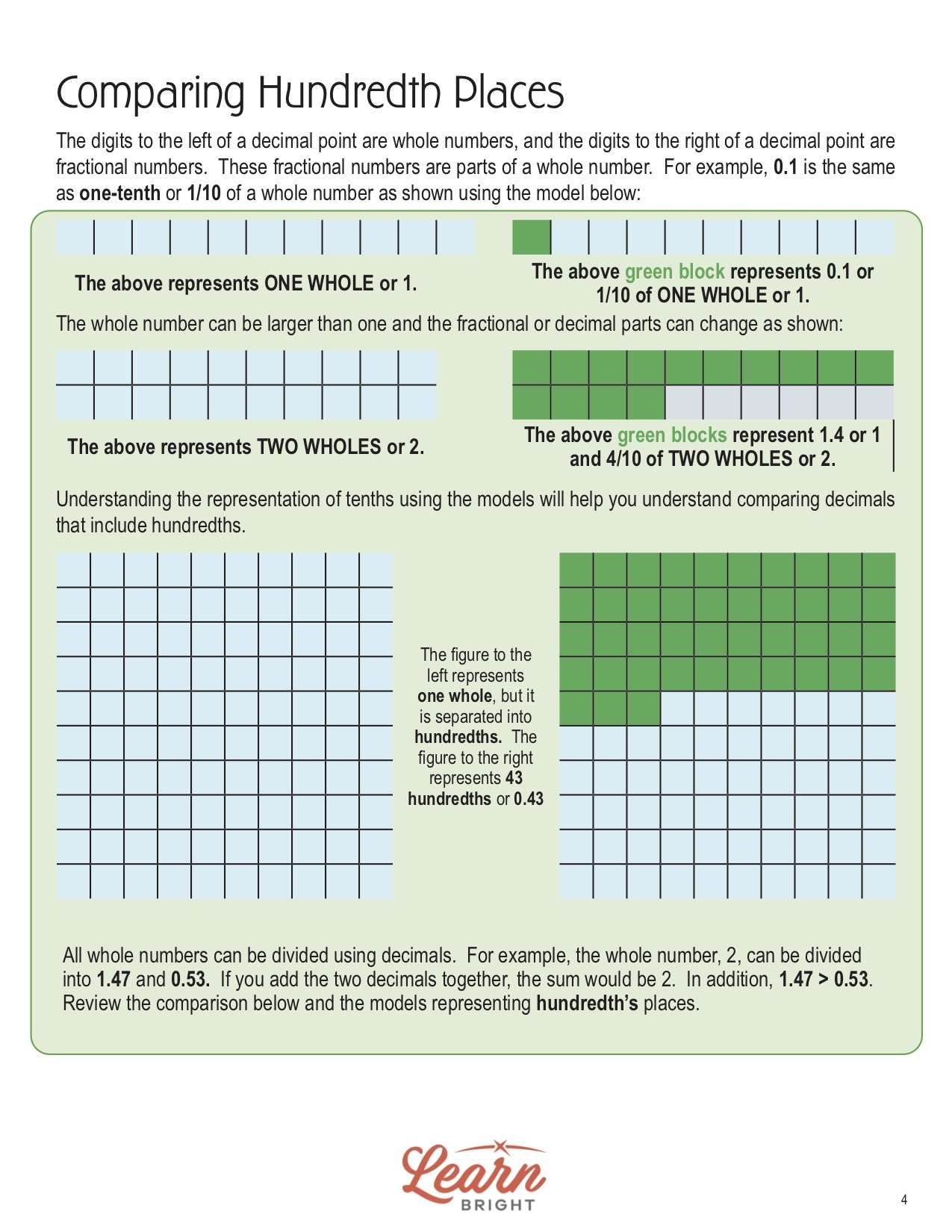Description
What our Decimal Comparison – Hundredths lesson plan includes
Lesson Objectives and Overview: Decimal Comparison – Hundredths teaches students how to compare two decimal numbers. Students will reason about the size of the numbers to figure out which is larger or smaller. By the end of the lesson, they should be able to compare two decimal numbers correctly to the hundredths place. This lesson is for students in 4th grade.
Classroom Procedure
Every lesson plan provides you with a classroom procedure page that outlines a step-by-step guide to follow. You do not have to follow the guide exactly. The guide helps you organize the lesson and details when to hand out worksheets. It also lists information in the orange box that you might find useful. You will find the lesson objectives, state standards, and number of class sessions the lesson should take to complete in this area. In addition, it describes the supplies you will need as well as what and how you need to prepare beforehand.
Options for Lesson
Included with this lesson is an “Options for Lesson” section that lists a number of suggestions for activities to add to the lesson or substitutions for the ones already in the lesson. One optional addition to the lesson is to have your students share with the class the method they used during the activity and have them vote on the best new method or most creative method. Another option is to have students create a big poster showing a decimal model using their favorite decimal number. You could also have students look at food menus and compare and sort prices.
Teacher Notes
The teacher notes page includes a paragraph with additional guidelines and things to think about as you begin to plan your lesson. This page also includes lines that you can use to add your own notes as you’re preparing for this lesson.
DECIMAL COMPARISON–HUNDREDTHS LESSON PLAN CONTENT PAGES
Comparing Numbers
The Decimal Comparison – Hundredths lesson plan includes three pages of content. When we compare numbers, we consider which is greater or smaller, or if they are equal. We use symbols when comparing numbers–an equal sign (=) when they have the same value, a less than sign (<) to show a smaller number, or a greater than sign (>) to show a larger number. When using these symbols, the point or tip of the symbol points towards the smaller number.
The lesson shows some example number comparisons using symbols, like 5 = 5, 21 < 32, and 8 > 7. All of these examples show comparisons using whole numbers, but we can compare numbers with decimals, too! Decimal numbers that show tenths have one digit to the right of the decimal point. For example, 1.8 is one and eight tenths and 0.5 is five tenths.
We can compare decimals with tenths. The lesson shows some examples of these comparisons, like 1.5 = 1.50, 0.4 < 0.3, and 10.3 > 9.9. It’s important to note that decimals with a zero in the hundredths place can still be equal to decimals without the zeros (for example, 1.5 = 1.50 and 1.1 = 1.10). We don’t need to include the zeros, and can write these numbers without them (1.5 = 1.5 and 1.1 = 1.1).
We can also compare numbers that have numbers other than zero in the hundredths place, like the prices of items (for example, $1.45, $0.89, or $49.92). In the examples, we see a five, nine, and two in the hundredths place. We can use these to compare if all the other digits are the same.
Comparing Hundredths Places
Digits on the left side of a decimal are whole numbers, and digits on the right side are fractional numbers. Fractional numbers are part of a whole number. 0.1, for example, is the same as one tenth or 1/10. The lesson includes a helpful diagram to illustrate this. It shows a line with 10 blocks, which represent 1, or one whole. Next, it shows the same line with one green block. The green block represents 0.1 or 1/10 of the whole. It continues on to show examples of different fractions of larger whole numbers.
We can divide all whole numbers using decimals. For example, we can divide the whole number 2 into 1.47 and 0.53. If you added them together, they would equal 2. We can also compare the two decimals: 1.47 > 0.53.
We can compare decimals using figures, as illustrated in the lesson. We can also compare them without using a model. To do this, first compare the whole numbers. Next, identify and compare the tenths places and then the hundredths places. Make sure to remember that any zeros on the end of the number do not matter.
The lesson lists some examples comparing numbers with hundredths places: 1.03 < 2.03, 0.3 < 0.30, 1.53 > 1.35, and 0.61 < 0.59.
DECIMAL COMPARISON–HUNDREDTHS LESSON PLAN WORKSHEETS
The Decimal Comparison – Hundredths lesson plan includes three worksheets: an activity worksheet, a practice worksheet, and a homework assignment. You can refer to the guide on the classroom procedure page to determine when to hand out each worksheet.
INSTRUCTION POSTER ACTIVITY WORKSHEET
Students will work with a partner for the activity worksheet. (You can also have them work alone or in groups instead if you prefer.) Students will work together to create a poster that teaches people about the hundredths place in decimals. They will explain what it means and how to compare them. There is a blank box on the bottom half of the worksheet page that students can use to draw a rough draft or take notes of what they want to include. Then partners will meet with other students to compare work and demonstrate their methods.
SHADE THE BLOCKS PRACTICE WORKSHEET
The practice worksheet has two sections. For the first section, students must shade the blocks to represent certain decimals. There are four decimals in this section. The second section requires students to use the inequality symbols to compare decimals. There are nine problems in this section.
DECIMAL COMPARISON – HUNDREDTHS HOMEWORK ASSIGNMENT
For the homework assignment, students will first use inequality symbols to compare 15 different decimal pairs. Then they will sort the decimals in each row from smallest to largest. Finally, they will draw models to show three different comparisons. They can use extra paper if they need to.
Worksheet Answer Keys
This lesson plan includes answer keys for the practice worksheet and the homework assignment. If you choose to administer the lesson pages to your students via PDF, you will need to save a new file that omits these pages. Otherwise, you can simply print out the applicable pages and keep these as reference for yourself when grading assignments.









